UGB253 Management Accounting Assignment: Budgeting Analysis
VerifiedAdded on 2023/06/01
|16
|3933
|248
Homework Assignment
AI Summary
This document provides a comprehensive solution to a management accounting assignment. It begins with an overview of budgetary control, emphasizing the differences between fixed and flexible budgets, and the advantages of flexible budgeting in adapting to changing circumstances. The solution then delves into the preparation of flexible budgets and discusses their strengths and weaknesses. It explores the behavioral aspects of budgeting, including motivation, participation, and group effects. The assignment also includes a case study involving Citrus Grove and a potential offer from Borges, requiring an analysis of relevant costs, and a recommendation on whether to accept the offer. Furthermore, it defines qualitative factors and their importance in decision-making. Finally, the document provides recommendations for Citrus Grove based on different scenarios, including outsourcing, and highlights the importance of considering both quantitative and qualitative aspects in business decisions.
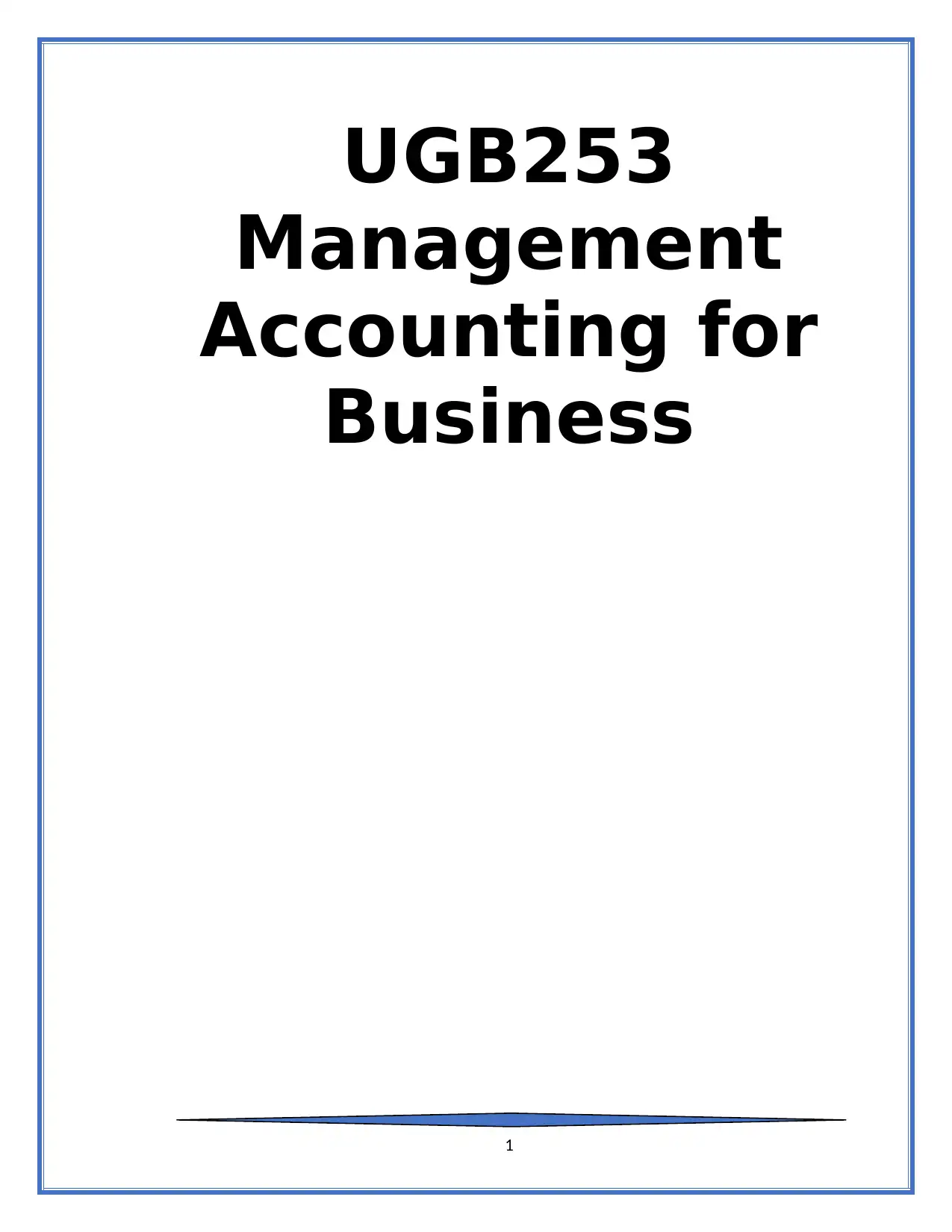
UGB253
Management
Accounting for
Business
1
Management
Accounting for
Business
1
Paraphrase This Document
Need a fresh take? Get an instant paraphrase of this document with our AI Paraphraser
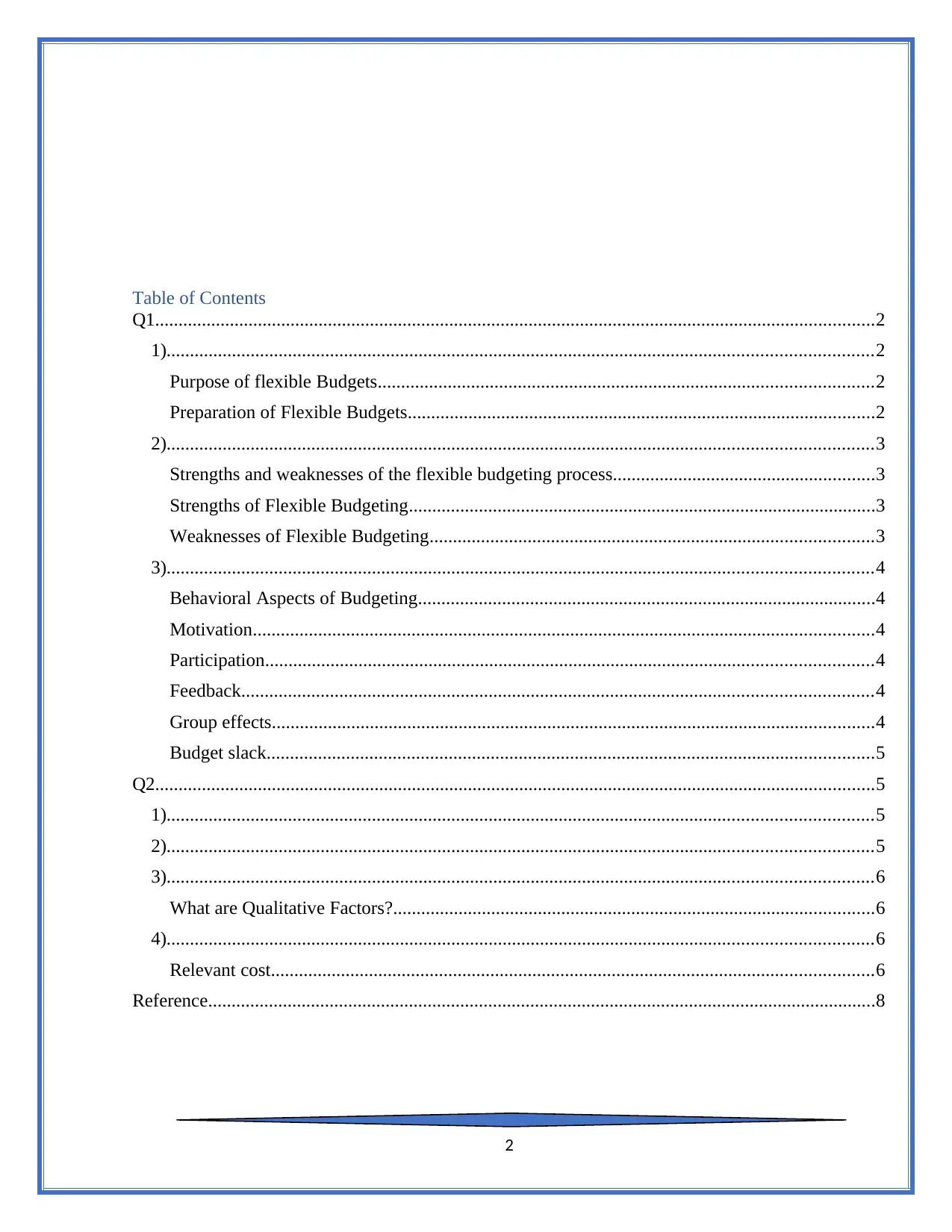
Table of Contents
Q1..........................................................................................................................................................2
1).......................................................................................................................................................2
Purpose of flexible Budgets..........................................................................................................2
Preparation of Flexible Budgets....................................................................................................2
2).......................................................................................................................................................3
Strengths and weaknesses of the flexible budgeting process........................................................3
Strengths of Flexible Budgeting....................................................................................................3
Weaknesses of Flexible Budgeting...............................................................................................3
3).......................................................................................................................................................4
Behavioral Aspects of Budgeting..................................................................................................4
Motivation.....................................................................................................................................4
Participation..................................................................................................................................4
Feedback.......................................................................................................................................4
Group effects.................................................................................................................................4
Budget slack..................................................................................................................................5
Q2..........................................................................................................................................................5
1).......................................................................................................................................................5
2).......................................................................................................................................................5
3).......................................................................................................................................................6
What are Qualitative Factors?.......................................................................................................6
4).......................................................................................................................................................6
Relevant cost.................................................................................................................................6
Reference...............................................................................................................................................8
2
Q1..........................................................................................................................................................2
1).......................................................................................................................................................2
Purpose of flexible Budgets..........................................................................................................2
Preparation of Flexible Budgets....................................................................................................2
2).......................................................................................................................................................3
Strengths and weaknesses of the flexible budgeting process........................................................3
Strengths of Flexible Budgeting....................................................................................................3
Weaknesses of Flexible Budgeting...............................................................................................3
3).......................................................................................................................................................4
Behavioral Aspects of Budgeting..................................................................................................4
Motivation.....................................................................................................................................4
Participation..................................................................................................................................4
Feedback.......................................................................................................................................4
Group effects.................................................................................................................................4
Budget slack..................................................................................................................................5
Q2..........................................................................................................................................................5
1).......................................................................................................................................................5
2).......................................................................................................................................................5
3).......................................................................................................................................................6
What are Qualitative Factors?.......................................................................................................6
4).......................................................................................................................................................6
Relevant cost.................................................................................................................................6
Reference...............................................................................................................................................8
2

Task 1
3
3
⊘ This is a preview!⊘
Do you want full access?
Subscribe today to unlock all pages.

Trusted by 1+ million students worldwide
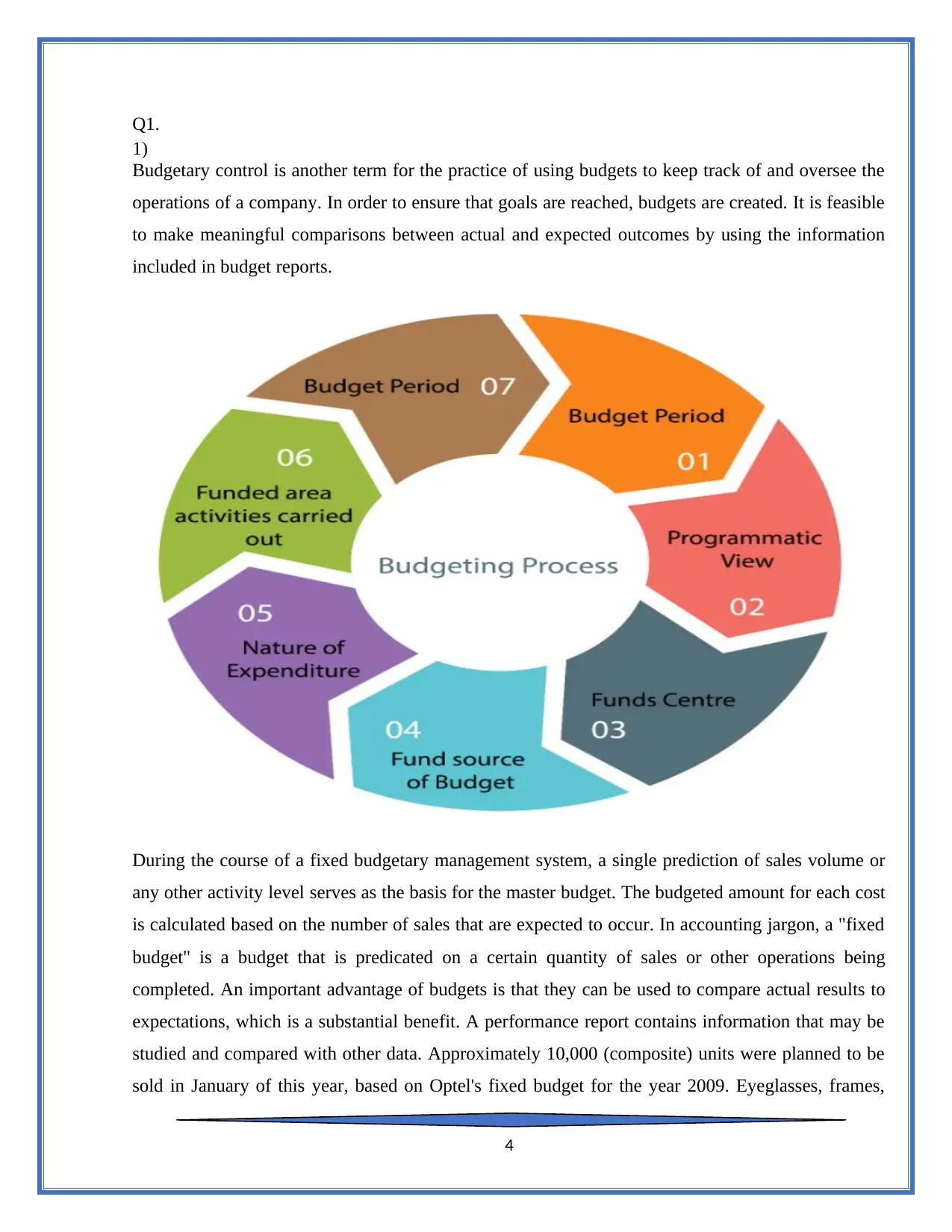
Q1.
1)
Budgetary control is another term for the practice of using budgets to keep track of and oversee the
operations of a company. In order to ensure that goals are reached, budgets are created. It is feasible
to make meaningful comparisons between actual and expected outcomes by using the information
included in budget reports.
During the course of a fixed budgetary management system, a single prediction of sales volume or
any other activity level serves as the basis for the master budget. The budgeted amount for each cost
is calculated based on the number of sales that are expected to occur. In accounting jargon, a "fixed
budget" is a budget that is predicated on a certain quantity of sales or other operations being
completed. An important advantage of budgets is that they can be used to compare actual results to
expectations, which is a substantial benefit. A performance report contains information that may be
studied and compared with other data. Approximately 10,000 (composite) units were planned to be
sold in January of this year, based on Optel's fixed budget for the year 2009. Eyeglasses, frames,
4
1)
Budgetary control is another term for the practice of using budgets to keep track of and oversee the
operations of a company. In order to ensure that goals are reached, budgets are created. It is feasible
to make meaningful comparisons between actual and expected outcomes by using the information
included in budget reports.
During the course of a fixed budgetary management system, a single prediction of sales volume or
any other activity level serves as the basis for the master budget. The budgeted amount for each cost
is calculated based on the number of sales that are expected to occur. In accounting jargon, a "fixed
budget" is a budget that is predicated on a certain quantity of sales or other operations being
completed. An important advantage of budgets is that they can be used to compare actual results to
expectations, which is a substantial benefit. A performance report contains information that may be
studied and compared with other data. Approximately 10,000 (composite) units were planned to be
sold in January of this year, based on Optel's fixed budget for the year 2009. Eyeglasses, frames,
4
Paraphrase This Document
Need a fresh take? Get an instant paraphrase of this document with our AI Paraphraser
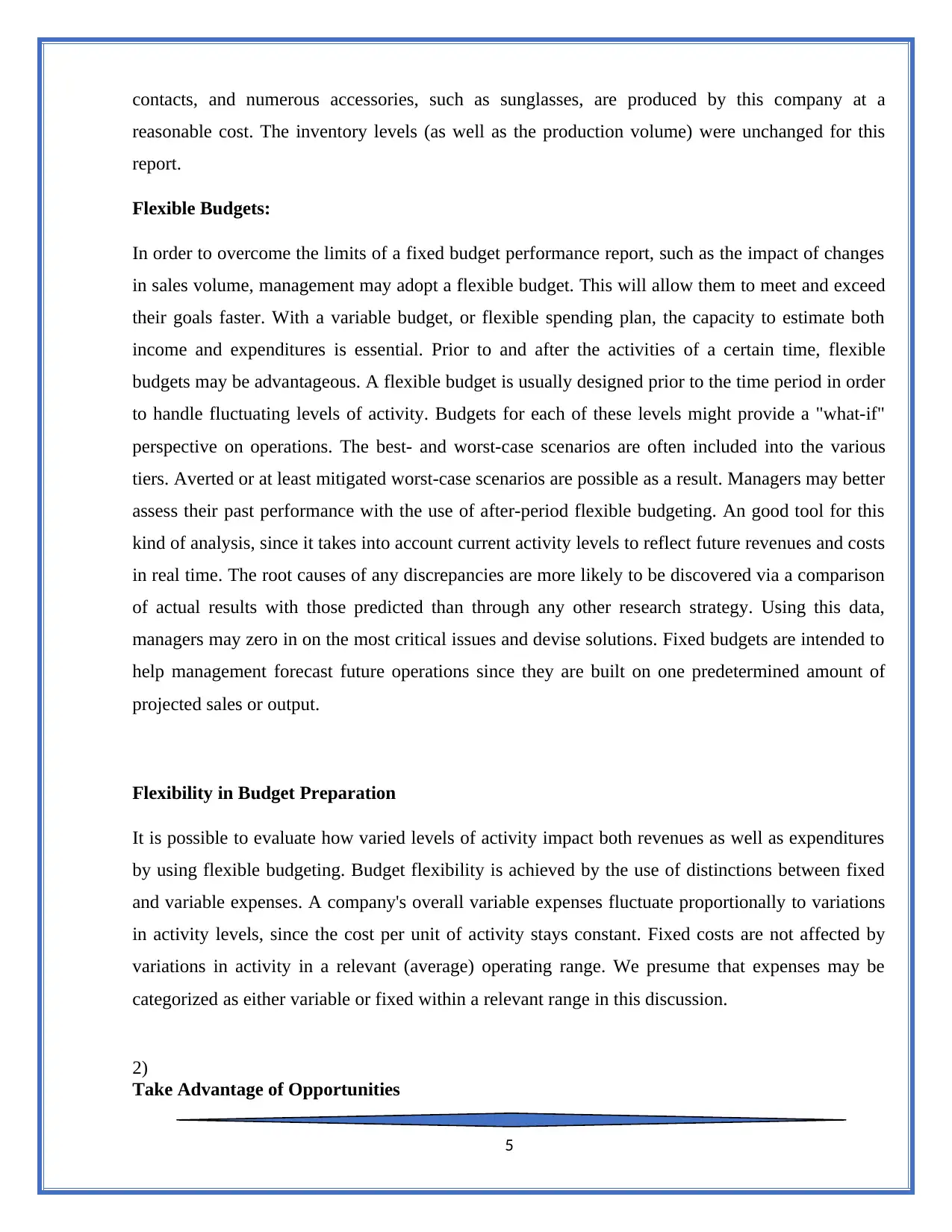
contacts, and numerous accessories, such as sunglasses, are produced by this company at a
reasonable cost. The inventory levels (as well as the production volume) were unchanged for this
report.
Flexible Budgets:
In order to overcome the limits of a fixed budget performance report, such as the impact of changes
in sales volume, management may adopt a flexible budget. This will allow them to meet and exceed
their goals faster. With a variable budget, or flexible spending plan, the capacity to estimate both
income and expenditures is essential. Prior to and after the activities of a certain time, flexible
budgets may be advantageous. A flexible budget is usually designed prior to the time period in order
to handle fluctuating levels of activity. Budgets for each of these levels might provide a "what-if"
perspective on operations. The best- and worst-case scenarios are often included into the various
tiers. Averted or at least mitigated worst-case scenarios are possible as a result. Managers may better
assess their past performance with the use of after-period flexible budgeting. An good tool for this
kind of analysis, since it takes into account current activity levels to reflect future revenues and costs
in real time. The root causes of any discrepancies are more likely to be discovered via a comparison
of actual results with those predicted than through any other research strategy. Using this data,
managers may zero in on the most critical issues and devise solutions. Fixed budgets are intended to
help management forecast future operations since they are built on one predetermined amount of
projected sales or output.
Flexibility in Budget Preparation
It is possible to evaluate how varied levels of activity impact both revenues as well as expenditures
by using flexible budgeting. Budget flexibility is achieved by the use of distinctions between fixed
and variable expenses. A company's overall variable expenses fluctuate proportionally to variations
in activity levels, since the cost per unit of activity stays constant. Fixed costs are not affected by
variations in activity in a relevant (average) operating range. We presume that expenses may be
categorized as either variable or fixed within a relevant range in this discussion.
2)
Take Advantage of Opportunities
5
reasonable cost. The inventory levels (as well as the production volume) were unchanged for this
report.
Flexible Budgets:
In order to overcome the limits of a fixed budget performance report, such as the impact of changes
in sales volume, management may adopt a flexible budget. This will allow them to meet and exceed
their goals faster. With a variable budget, or flexible spending plan, the capacity to estimate both
income and expenditures is essential. Prior to and after the activities of a certain time, flexible
budgets may be advantageous. A flexible budget is usually designed prior to the time period in order
to handle fluctuating levels of activity. Budgets for each of these levels might provide a "what-if"
perspective on operations. The best- and worst-case scenarios are often included into the various
tiers. Averted or at least mitigated worst-case scenarios are possible as a result. Managers may better
assess their past performance with the use of after-period flexible budgeting. An good tool for this
kind of analysis, since it takes into account current activity levels to reflect future revenues and costs
in real time. The root causes of any discrepancies are more likely to be discovered via a comparison
of actual results with those predicted than through any other research strategy. Using this data,
managers may zero in on the most critical issues and devise solutions. Fixed budgets are intended to
help management forecast future operations since they are built on one predetermined amount of
projected sales or output.
Flexibility in Budget Preparation
It is possible to evaluate how varied levels of activity impact both revenues as well as expenditures
by using flexible budgeting. Budget flexibility is achieved by the use of distinctions between fixed
and variable expenses. A company's overall variable expenses fluctuate proportionally to variations
in activity levels, since the cost per unit of activity stays constant. Fixed costs are not affected by
variations in activity in a relevant (average) operating range. We presume that expenses may be
categorized as either variable or fixed within a relevant range in this discussion.
2)
Take Advantage of Opportunities
5
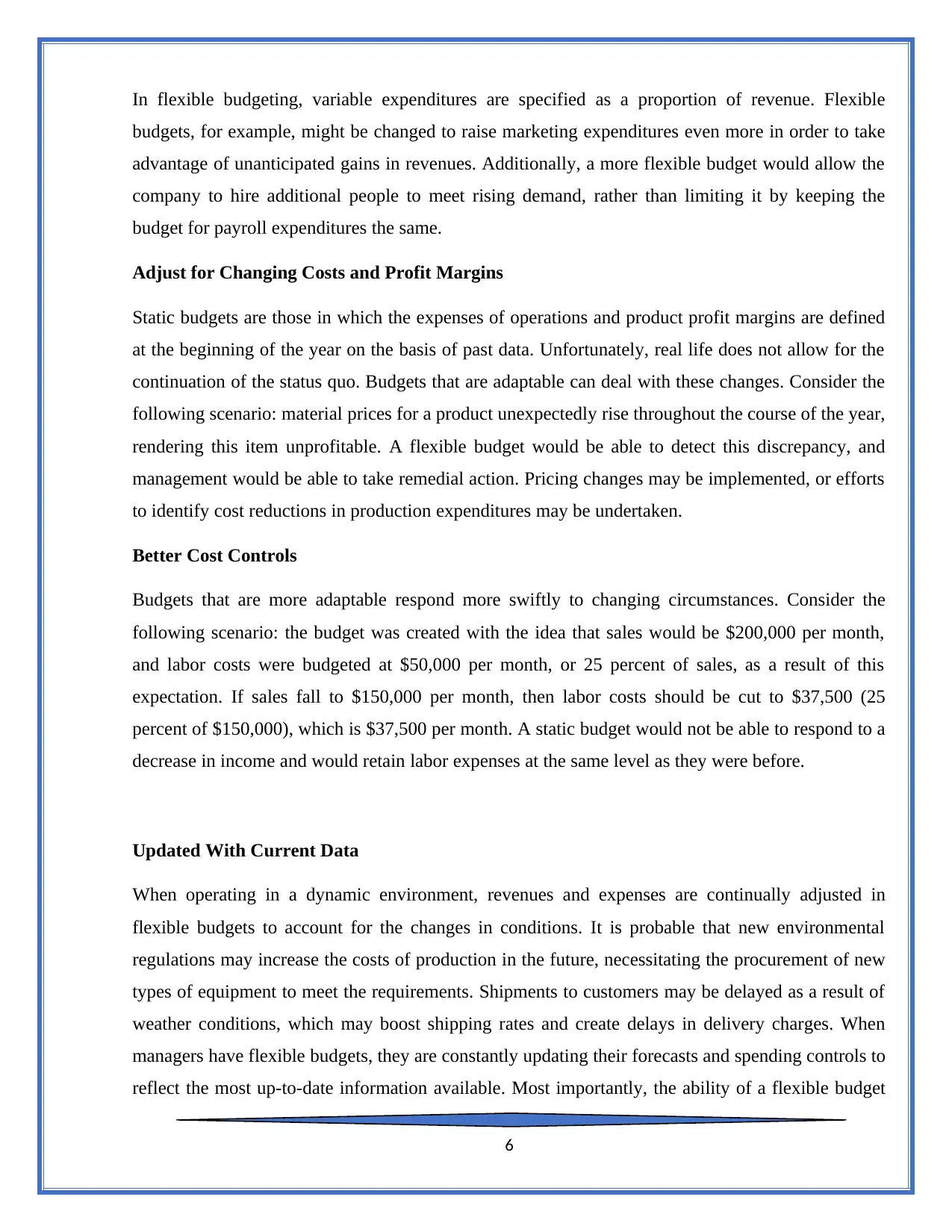
In flexible budgeting, variable expenditures are specified as a proportion of revenue. Flexible
budgets, for example, might be changed to raise marketing expenditures even more in order to take
advantage of unanticipated gains in revenues. Additionally, a more flexible budget would allow the
company to hire additional people to meet rising demand, rather than limiting it by keeping the
budget for payroll expenditures the same.
Adjust for Changing Costs and Profit Margins
Static budgets are those in which the expenses of operations and product profit margins are defined
at the beginning of the year on the basis of past data. Unfortunately, real life does not allow for the
continuation of the status quo. Budgets that are adaptable can deal with these changes. Consider the
following scenario: material prices for a product unexpectedly rise throughout the course of the year,
rendering this item unprofitable. A flexible budget would be able to detect this discrepancy, and
management would be able to take remedial action. Pricing changes may be implemented, or efforts
to identify cost reductions in production expenditures may be undertaken.
Better Cost Controls
Budgets that are more adaptable respond more swiftly to changing circumstances. Consider the
following scenario: the budget was created with the idea that sales would be $200,000 per month,
and labor costs were budgeted at $50,000 per month, or 25 percent of sales, as a result of this
expectation. If sales fall to $150,000 per month, then labor costs should be cut to $37,500 (25
percent of $150,000), which is $37,500 per month. A static budget would not be able to respond to a
decrease in income and would retain labor expenses at the same level as they were before.
Updated With Current Data
When operating in a dynamic environment, revenues and expenses are continually adjusted in
flexible budgets to account for the changes in conditions. It is probable that new environmental
regulations may increase the costs of production in the future, necessitating the procurement of new
types of equipment to meet the requirements. Shipments to customers may be delayed as a result of
weather conditions, which may boost shipping rates and create delays in delivery charges. When
managers have flexible budgets, they are constantly updating their forecasts and spending controls to
reflect the most up-to-date information available. Most importantly, the ability of a flexible budget
6
budgets, for example, might be changed to raise marketing expenditures even more in order to take
advantage of unanticipated gains in revenues. Additionally, a more flexible budget would allow the
company to hire additional people to meet rising demand, rather than limiting it by keeping the
budget for payroll expenditures the same.
Adjust for Changing Costs and Profit Margins
Static budgets are those in which the expenses of operations and product profit margins are defined
at the beginning of the year on the basis of past data. Unfortunately, real life does not allow for the
continuation of the status quo. Budgets that are adaptable can deal with these changes. Consider the
following scenario: material prices for a product unexpectedly rise throughout the course of the year,
rendering this item unprofitable. A flexible budget would be able to detect this discrepancy, and
management would be able to take remedial action. Pricing changes may be implemented, or efforts
to identify cost reductions in production expenditures may be undertaken.
Better Cost Controls
Budgets that are more adaptable respond more swiftly to changing circumstances. Consider the
following scenario: the budget was created with the idea that sales would be $200,000 per month,
and labor costs were budgeted at $50,000 per month, or 25 percent of sales, as a result of this
expectation. If sales fall to $150,000 per month, then labor costs should be cut to $37,500 (25
percent of $150,000), which is $37,500 per month. A static budget would not be able to respond to a
decrease in income and would retain labor expenses at the same level as they were before.
Updated With Current Data
When operating in a dynamic environment, revenues and expenses are continually adjusted in
flexible budgets to account for the changes in conditions. It is probable that new environmental
regulations may increase the costs of production in the future, necessitating the procurement of new
types of equipment to meet the requirements. Shipments to customers may be delayed as a result of
weather conditions, which may boost shipping rates and create delays in delivery charges. When
managers have flexible budgets, they are constantly updating their forecasts and spending controls to
reflect the most up-to-date information available. Most importantly, the ability of a flexible budget
6
⊘ This is a preview!⊘
Do you want full access?
Subscribe today to unlock all pages.

Trusted by 1+ million students worldwide
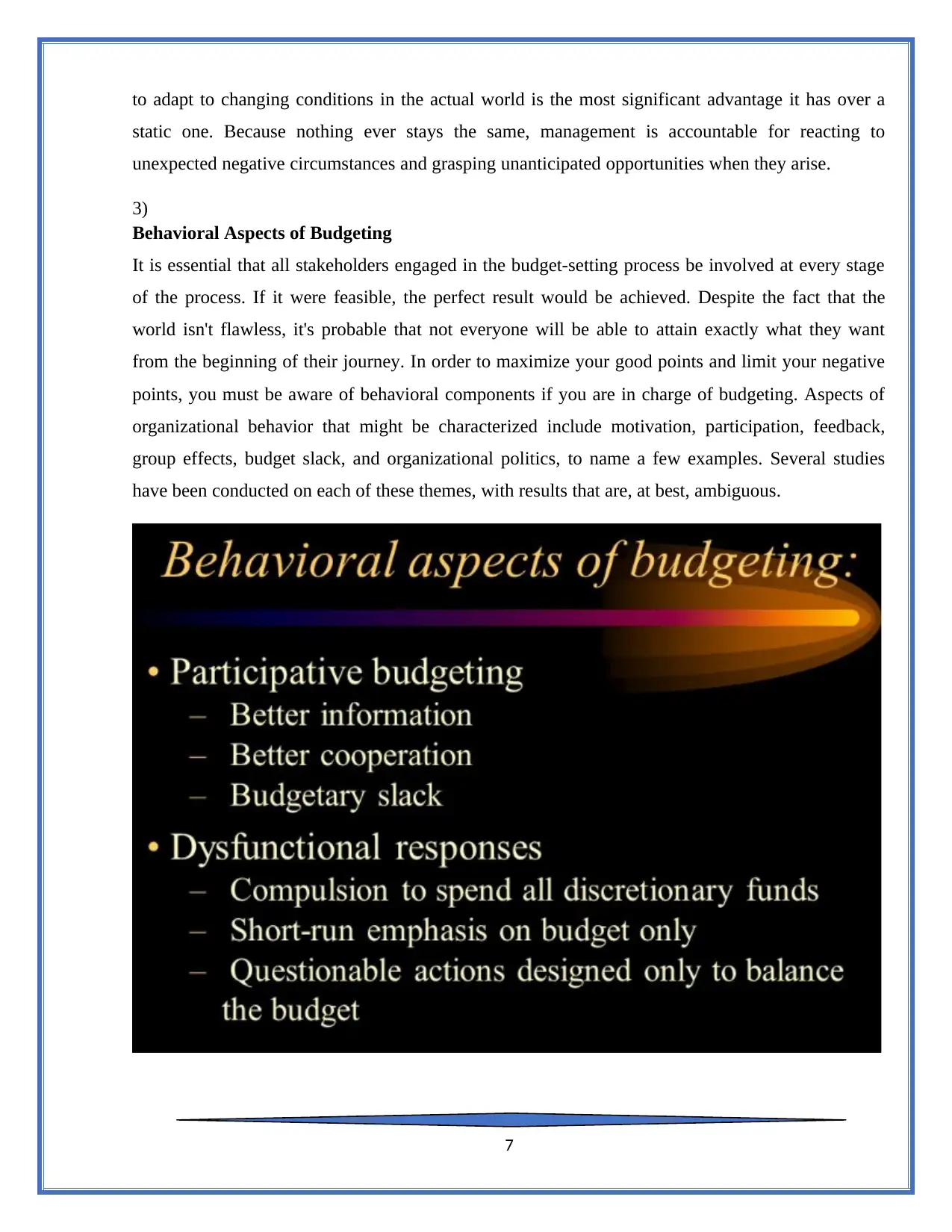
to adapt to changing conditions in the actual world is the most significant advantage it has over a
static one. Because nothing ever stays the same, management is accountable for reacting to
unexpected negative circumstances and grasping unanticipated opportunities when they arise.
3)
Behavioral Aspects of Budgeting
It is essential that all stakeholders engaged in the budget-setting process be involved at every stage
of the process. If it were feasible, the perfect result would be achieved. Despite the fact that the
world isn't flawless, it's probable that not everyone will be able to attain exactly what they want
from the beginning of their journey. In order to maximize your good points and limit your negative
points, you must be aware of behavioral components if you are in charge of budgeting. Aspects of
organizational behavior that might be characterized include motivation, participation, feedback,
group effects, budget slack, and organizational politics, to name a few examples. Several studies
have been conducted on each of these themes, with results that are, at best, ambiguous.
7
static one. Because nothing ever stays the same, management is accountable for reacting to
unexpected negative circumstances and grasping unanticipated opportunities when they arise.
3)
Behavioral Aspects of Budgeting
It is essential that all stakeholders engaged in the budget-setting process be involved at every stage
of the process. If it were feasible, the perfect result would be achieved. Despite the fact that the
world isn't flawless, it's probable that not everyone will be able to attain exactly what they want
from the beginning of their journey. In order to maximize your good points and limit your negative
points, you must be aware of behavioral components if you are in charge of budgeting. Aspects of
organizational behavior that might be characterized include motivation, participation, feedback,
group effects, budget slack, and organizational politics, to name a few examples. Several studies
have been conducted on each of these themes, with results that are, at best, ambiguous.
7
Paraphrase This Document
Need a fresh take? Get an instant paraphrase of this document with our AI Paraphraser
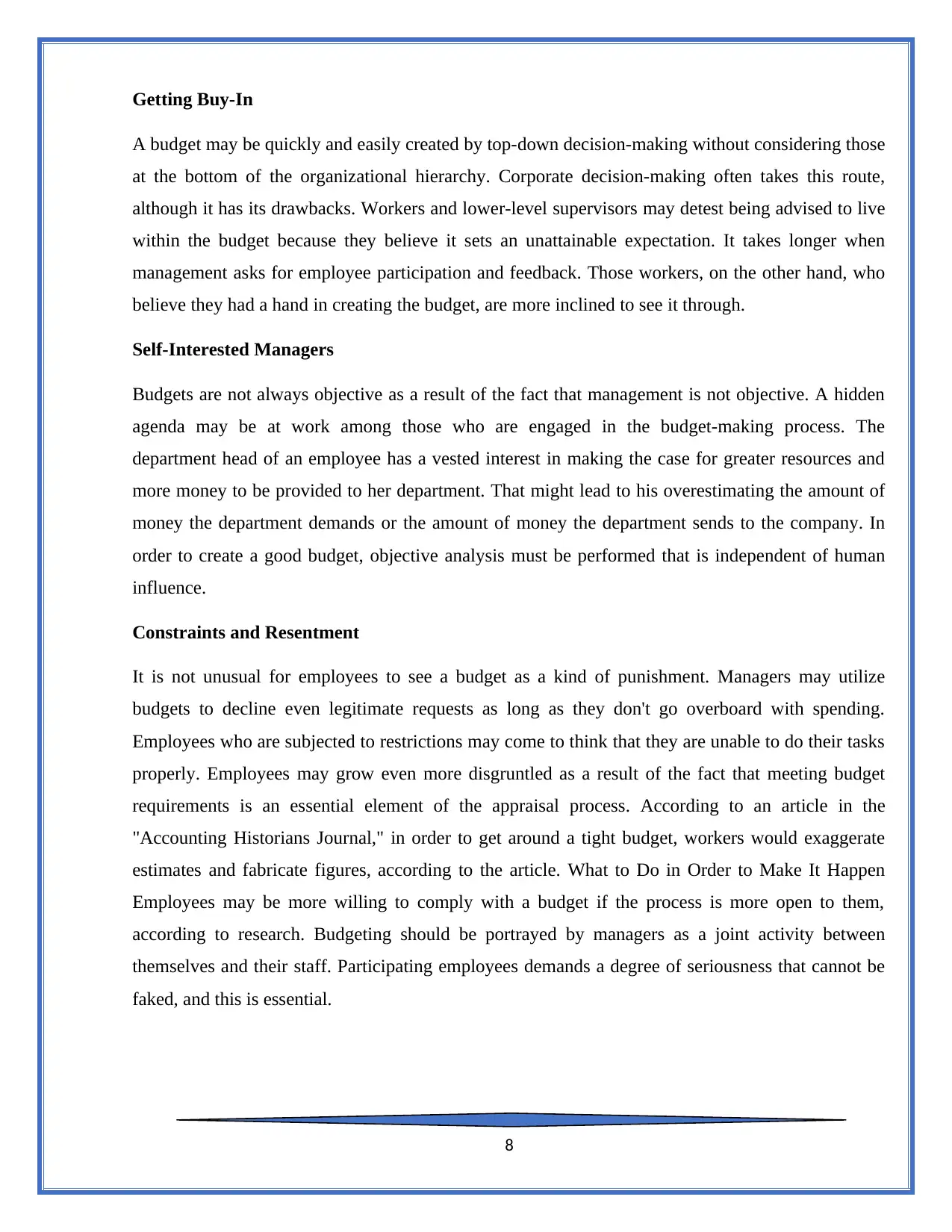
Getting Buy-In
A budget may be quickly and easily created by top-down decision-making without considering those
at the bottom of the organizational hierarchy. Corporate decision-making often takes this route,
although it has its drawbacks. Workers and lower-level supervisors may detest being advised to live
within the budget because they believe it sets an unattainable expectation. It takes longer when
management asks for employee participation and feedback. Those workers, on the other hand, who
believe they had a hand in creating the budget, are more inclined to see it through.
Self-Interested Managers
Budgets are not always objective as a result of the fact that management is not objective. A hidden
agenda may be at work among those who are engaged in the budget-making process. The
department head of an employee has a vested interest in making the case for greater resources and
more money to be provided to her department. That might lead to his overestimating the amount of
money the department demands or the amount of money the department sends to the company. In
order to create a good budget, objective analysis must be performed that is independent of human
influence.
Constraints and Resentment
It is not unusual for employees to see a budget as a kind of punishment. Managers may utilize
budgets to decline even legitimate requests as long as they don't go overboard with spending.
Employees who are subjected to restrictions may come to think that they are unable to do their tasks
properly. Employees may grow even more disgruntled as a result of the fact that meeting budget
requirements is an essential element of the appraisal process. According to an article in the
"Accounting Historians Journal," in order to get around a tight budget, workers would exaggerate
estimates and fabricate figures, according to the article. What to Do in Order to Make It Happen
Employees may be more willing to comply with a budget if the process is more open to them,
according to research. Budgeting should be portrayed by managers as a joint activity between
themselves and their staff. Participating employees demands a degree of seriousness that cannot be
faked, and this is essential.
8
A budget may be quickly and easily created by top-down decision-making without considering those
at the bottom of the organizational hierarchy. Corporate decision-making often takes this route,
although it has its drawbacks. Workers and lower-level supervisors may detest being advised to live
within the budget because they believe it sets an unattainable expectation. It takes longer when
management asks for employee participation and feedback. Those workers, on the other hand, who
believe they had a hand in creating the budget, are more inclined to see it through.
Self-Interested Managers
Budgets are not always objective as a result of the fact that management is not objective. A hidden
agenda may be at work among those who are engaged in the budget-making process. The
department head of an employee has a vested interest in making the case for greater resources and
more money to be provided to her department. That might lead to his overestimating the amount of
money the department demands or the amount of money the department sends to the company. In
order to create a good budget, objective analysis must be performed that is independent of human
influence.
Constraints and Resentment
It is not unusual for employees to see a budget as a kind of punishment. Managers may utilize
budgets to decline even legitimate requests as long as they don't go overboard with spending.
Employees who are subjected to restrictions may come to think that they are unable to do their tasks
properly. Employees may grow even more disgruntled as a result of the fact that meeting budget
requirements is an essential element of the appraisal process. According to an article in the
"Accounting Historians Journal," in order to get around a tight budget, workers would exaggerate
estimates and fabricate figures, according to the article. What to Do in Order to Make It Happen
Employees may be more willing to comply with a budget if the process is more open to them,
according to research. Budgeting should be portrayed by managers as a joint activity between
themselves and their staff. Participating employees demands a degree of seriousness that cannot be
faked, and this is essential.
8
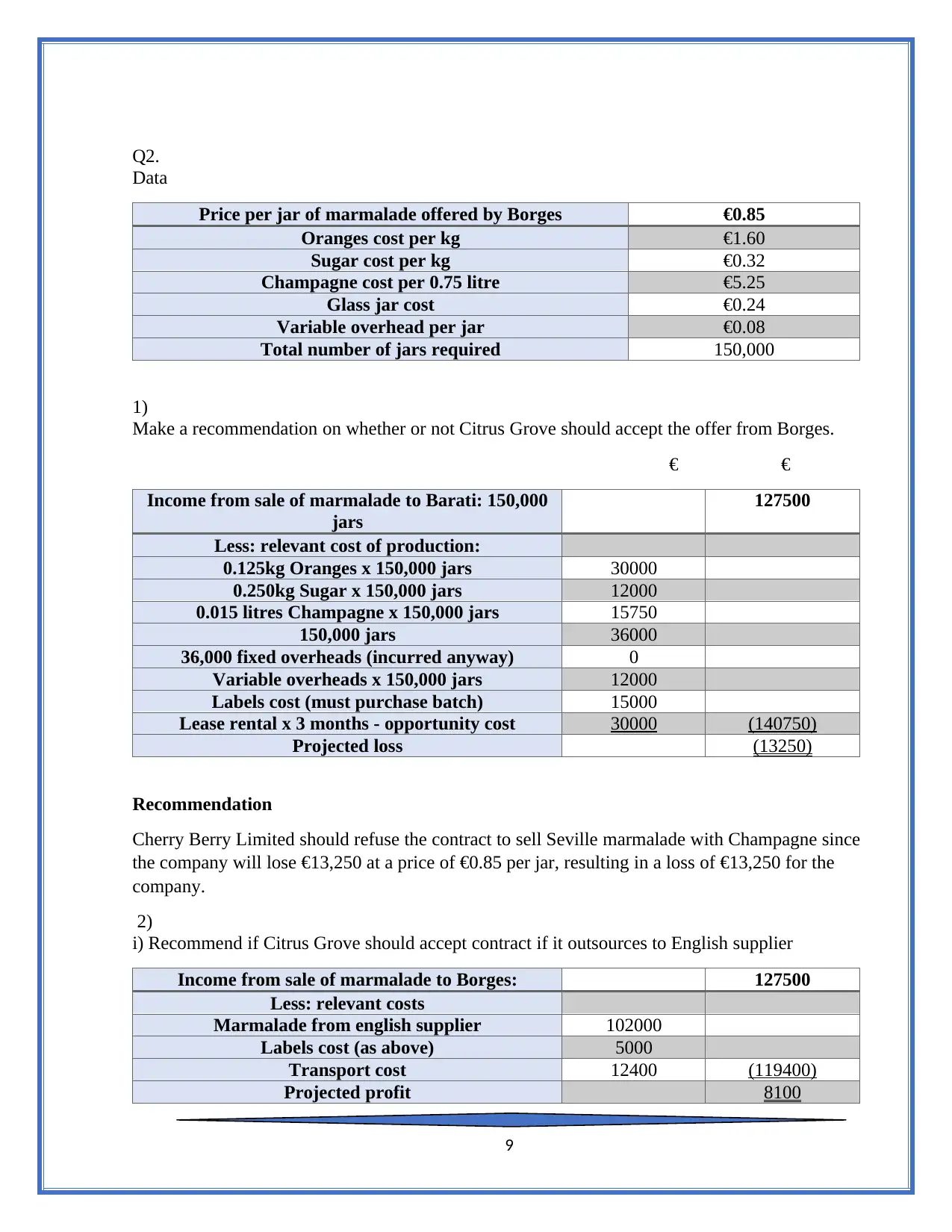
Q2.
Data
Price per jar of marmalade offered by Borges €0.85
Oranges cost per kg €1.60
Sugar cost per kg €0.32
Champagne cost per 0.75 litre €5.25
Glass jar cost €0.24
Variable overhead per jar €0.08
Total number of jars required 150,000
1)
Make a recommendation on whether or not Citrus Grove should accept the offer from Borges.
€ €
Income from sale of marmalade to Barati: 150,000
jars
127500
Less: relevant cost of production:
0.125kg Oranges x 150,000 jars 30000
0.250kg Sugar x 150,000 jars 12000
0.015 litres Champagne x 150,000 jars 15750
150,000 jars 36000
36,000 fixed overheads (incurred anyway) 0
Variable overheads x 150,000 jars 12000
Labels cost (must purchase batch) 15000
Lease rental x 3 months - opportunity cost 30000 (140750)
Projected loss (13250)
Recommendation
Cherry Berry Limited should refuse the contract to sell Seville marmalade with Champagne since
the company will lose €13,250 at a price of €0.85 per jar, resulting in a loss of €13,250 for the
company.
2)
i) Recommend if Citrus Grove should accept contract if it outsources to English supplier
Income from sale of marmalade to Borges: 127500
Less: relevant costs
Marmalade from english supplier 102000
Labels cost (as above) 5000
Transport cost 12400 (119400)
Projected profit 8100
9
Data
Price per jar of marmalade offered by Borges €0.85
Oranges cost per kg €1.60
Sugar cost per kg €0.32
Champagne cost per 0.75 litre €5.25
Glass jar cost €0.24
Variable overhead per jar €0.08
Total number of jars required 150,000
1)
Make a recommendation on whether or not Citrus Grove should accept the offer from Borges.
€ €
Income from sale of marmalade to Barati: 150,000
jars
127500
Less: relevant cost of production:
0.125kg Oranges x 150,000 jars 30000
0.250kg Sugar x 150,000 jars 12000
0.015 litres Champagne x 150,000 jars 15750
150,000 jars 36000
36,000 fixed overheads (incurred anyway) 0
Variable overheads x 150,000 jars 12000
Labels cost (must purchase batch) 15000
Lease rental x 3 months - opportunity cost 30000 (140750)
Projected loss (13250)
Recommendation
Cherry Berry Limited should refuse the contract to sell Seville marmalade with Champagne since
the company will lose €13,250 at a price of €0.85 per jar, resulting in a loss of €13,250 for the
company.
2)
i) Recommend if Citrus Grove should accept contract if it outsources to English supplier
Income from sale of marmalade to Borges: 127500
Less: relevant costs
Marmalade from english supplier 102000
Labels cost (as above) 5000
Transport cost 12400 (119400)
Projected profit 8100
9
⊘ This is a preview!⊘
Do you want full access?
Subscribe today to unlock all pages.

Trusted by 1+ million students worldwide
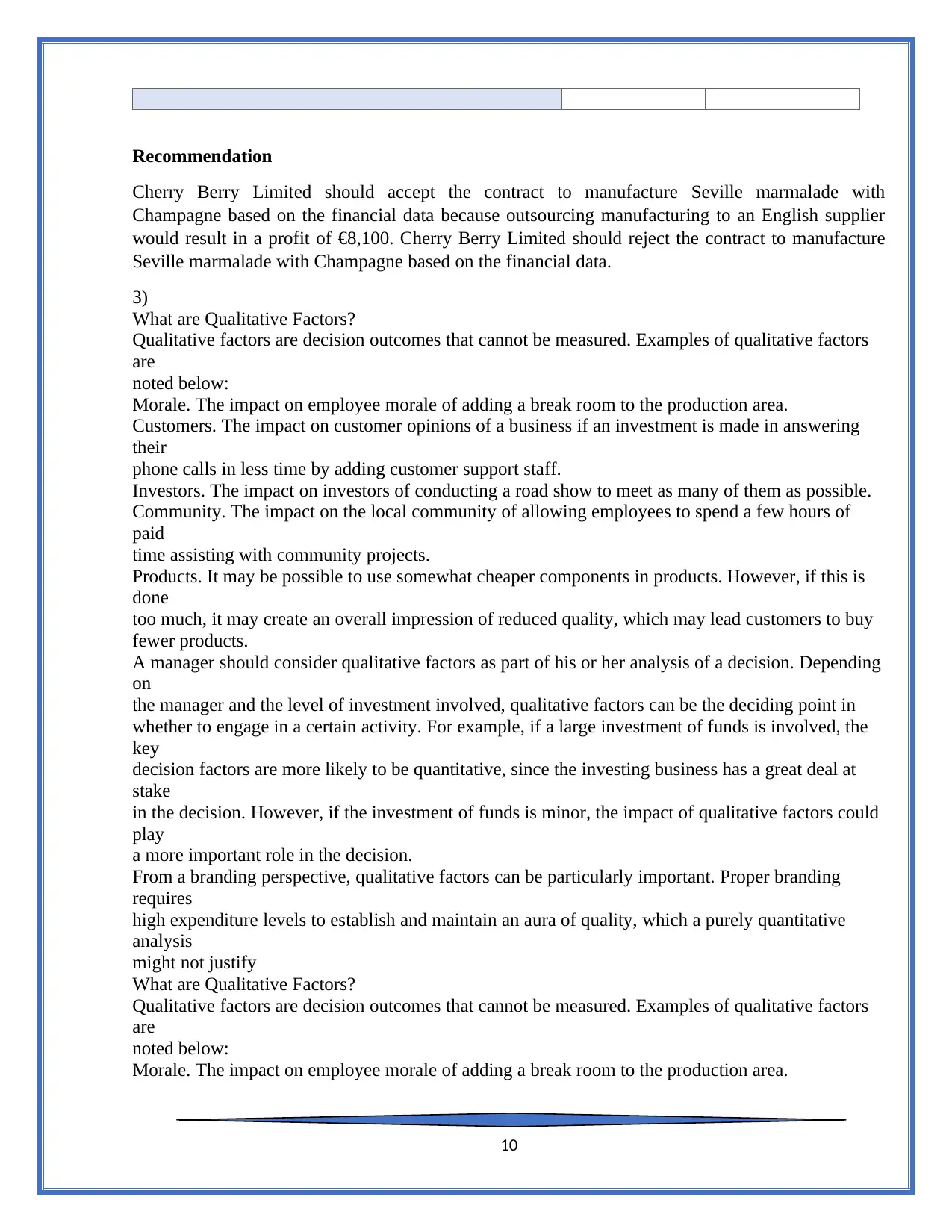
Recommendation
Cherry Berry Limited should accept the contract to manufacture Seville marmalade with
Champagne based on the financial data because outsourcing manufacturing to an English supplier
would result in a profit of €8,100. Cherry Berry Limited should reject the contract to manufacture
Seville marmalade with Champagne based on the financial data.
3)
What are Qualitative Factors?
Qualitative factors are decision outcomes that cannot be measured. Examples of qualitative factors
are
noted below:
Morale. The impact on employee morale of adding a break room to the production area.
Customers. The impact on customer opinions of a business if an investment is made in answering
their
phone calls in less time by adding customer support staff.
Investors. The impact on investors of conducting a road show to meet as many of them as possible.
Community. The impact on the local community of allowing employees to spend a few hours of
paid
time assisting with community projects.
Products. It may be possible to use somewhat cheaper components in products. However, if this is
done
too much, it may create an overall impression of reduced quality, which may lead customers to buy
fewer products.
A manager should consider qualitative factors as part of his or her analysis of a decision. Depending
on
the manager and the level of investment involved, qualitative factors can be the deciding point in
whether to engage in a certain activity. For example, if a large investment of funds is involved, the
key
decision factors are more likely to be quantitative, since the investing business has a great deal at
stake
in the decision. However, if the investment of funds is minor, the impact of qualitative factors could
play
a more important role in the decision.
From a branding perspective, qualitative factors can be particularly important. Proper branding
requires
high expenditure levels to establish and maintain an aura of quality, which a purely quantitative
analysis
might not justify
What are Qualitative Factors?
Qualitative factors are decision outcomes that cannot be measured. Examples of qualitative factors
are
noted below:
Morale. The impact on employee morale of adding a break room to the production area.
10
Cherry Berry Limited should accept the contract to manufacture Seville marmalade with
Champagne based on the financial data because outsourcing manufacturing to an English supplier
would result in a profit of €8,100. Cherry Berry Limited should reject the contract to manufacture
Seville marmalade with Champagne based on the financial data.
3)
What are Qualitative Factors?
Qualitative factors are decision outcomes that cannot be measured. Examples of qualitative factors
are
noted below:
Morale. The impact on employee morale of adding a break room to the production area.
Customers. The impact on customer opinions of a business if an investment is made in answering
their
phone calls in less time by adding customer support staff.
Investors. The impact on investors of conducting a road show to meet as many of them as possible.
Community. The impact on the local community of allowing employees to spend a few hours of
paid
time assisting with community projects.
Products. It may be possible to use somewhat cheaper components in products. However, if this is
done
too much, it may create an overall impression of reduced quality, which may lead customers to buy
fewer products.
A manager should consider qualitative factors as part of his or her analysis of a decision. Depending
on
the manager and the level of investment involved, qualitative factors can be the deciding point in
whether to engage in a certain activity. For example, if a large investment of funds is involved, the
key
decision factors are more likely to be quantitative, since the investing business has a great deal at
stake
in the decision. However, if the investment of funds is minor, the impact of qualitative factors could
play
a more important role in the decision.
From a branding perspective, qualitative factors can be particularly important. Proper branding
requires
high expenditure levels to establish and maintain an aura of quality, which a purely quantitative
analysis
might not justify
What are Qualitative Factors?
Qualitative factors are decision outcomes that cannot be measured. Examples of qualitative factors
are
noted below:
Morale. The impact on employee morale of adding a break room to the production area.
10
Paraphrase This Document
Need a fresh take? Get an instant paraphrase of this document with our AI Paraphraser
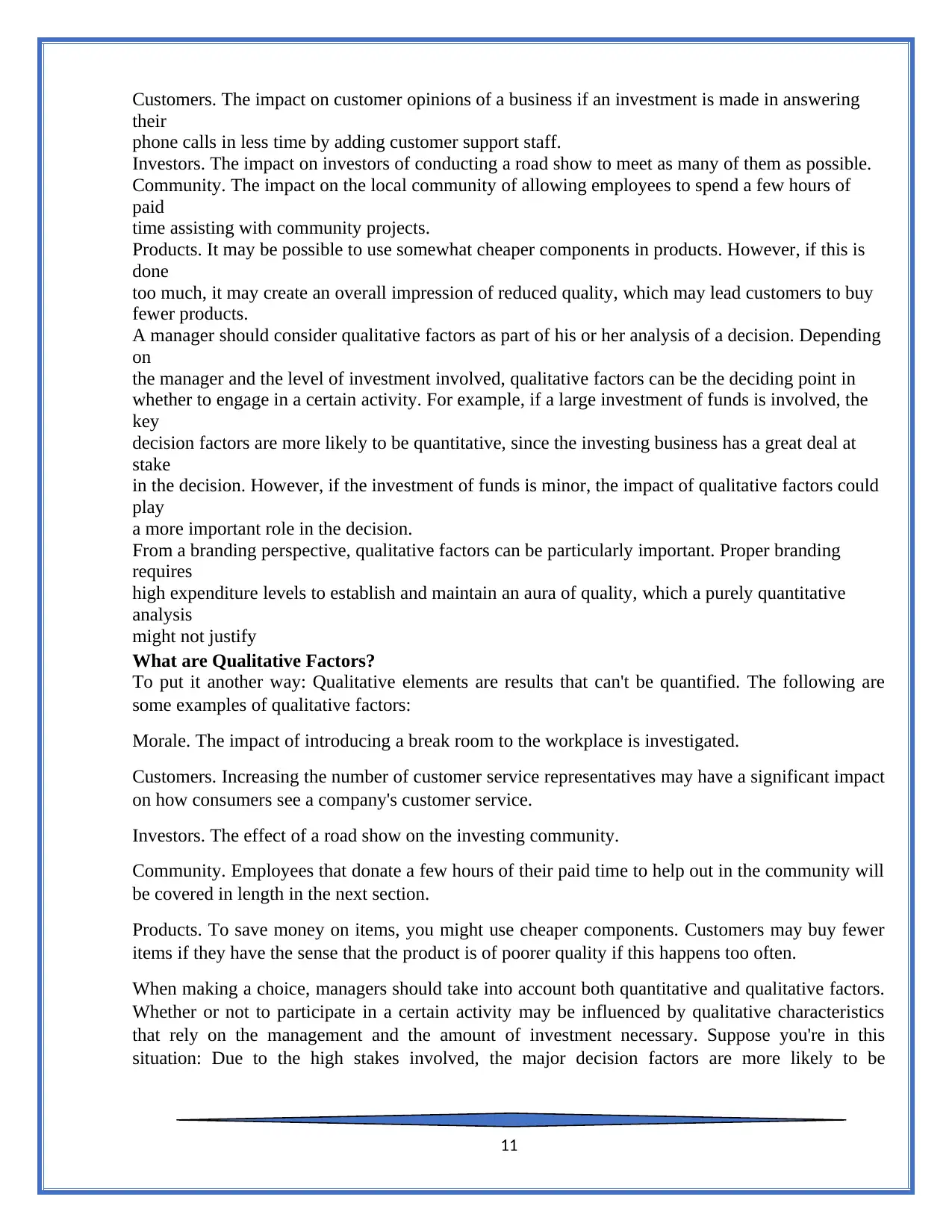
Customers. The impact on customer opinions of a business if an investment is made in answering
their
phone calls in less time by adding customer support staff.
Investors. The impact on investors of conducting a road show to meet as many of them as possible.
Community. The impact on the local community of allowing employees to spend a few hours of
paid
time assisting with community projects.
Products. It may be possible to use somewhat cheaper components in products. However, if this is
done
too much, it may create an overall impression of reduced quality, which may lead customers to buy
fewer products.
A manager should consider qualitative factors as part of his or her analysis of a decision. Depending
on
the manager and the level of investment involved, qualitative factors can be the deciding point in
whether to engage in a certain activity. For example, if a large investment of funds is involved, the
key
decision factors are more likely to be quantitative, since the investing business has a great deal at
stake
in the decision. However, if the investment of funds is minor, the impact of qualitative factors could
play
a more important role in the decision.
From a branding perspective, qualitative factors can be particularly important. Proper branding
requires
high expenditure levels to establish and maintain an aura of quality, which a purely quantitative
analysis
might not justify
What are Qualitative Factors?
To put it another way: Qualitative elements are results that can't be quantified. The following are
some examples of qualitative factors:
Morale. The impact of introducing a break room to the workplace is investigated.
Customers. Increasing the number of customer service representatives may have a significant impact
on how consumers see a company's customer service.
Investors. The effect of a road show on the investing community.
Community. Employees that donate a few hours of their paid time to help out in the community will
be covered in length in the next section.
Products. To save money on items, you might use cheaper components. Customers may buy fewer
items if they have the sense that the product is of poorer quality if this happens too often.
When making a choice, managers should take into account both quantitative and qualitative factors.
Whether or not to participate in a certain activity may be influenced by qualitative characteristics
that rely on the management and the amount of investment necessary. Suppose you're in this
situation: Due to the high stakes involved, the major decision factors are more likely to be
11
their
phone calls in less time by adding customer support staff.
Investors. The impact on investors of conducting a road show to meet as many of them as possible.
Community. The impact on the local community of allowing employees to spend a few hours of
paid
time assisting with community projects.
Products. It may be possible to use somewhat cheaper components in products. However, if this is
done
too much, it may create an overall impression of reduced quality, which may lead customers to buy
fewer products.
A manager should consider qualitative factors as part of his or her analysis of a decision. Depending
on
the manager and the level of investment involved, qualitative factors can be the deciding point in
whether to engage in a certain activity. For example, if a large investment of funds is involved, the
key
decision factors are more likely to be quantitative, since the investing business has a great deal at
stake
in the decision. However, if the investment of funds is minor, the impact of qualitative factors could
play
a more important role in the decision.
From a branding perspective, qualitative factors can be particularly important. Proper branding
requires
high expenditure levels to establish and maintain an aura of quality, which a purely quantitative
analysis
might not justify
What are Qualitative Factors?
To put it another way: Qualitative elements are results that can't be quantified. The following are
some examples of qualitative factors:
Morale. The impact of introducing a break room to the workplace is investigated.
Customers. Increasing the number of customer service representatives may have a significant impact
on how consumers see a company's customer service.
Investors. The effect of a road show on the investing community.
Community. Employees that donate a few hours of their paid time to help out in the community will
be covered in length in the next section.
Products. To save money on items, you might use cheaper components. Customers may buy fewer
items if they have the sense that the product is of poorer quality if this happens too often.
When making a choice, managers should take into account both quantitative and qualitative factors.
Whether or not to participate in a certain activity may be influenced by qualitative characteristics
that rely on the management and the amount of investment necessary. Suppose you're in this
situation: Due to the high stakes involved, the major decision factors are more likely to be
11
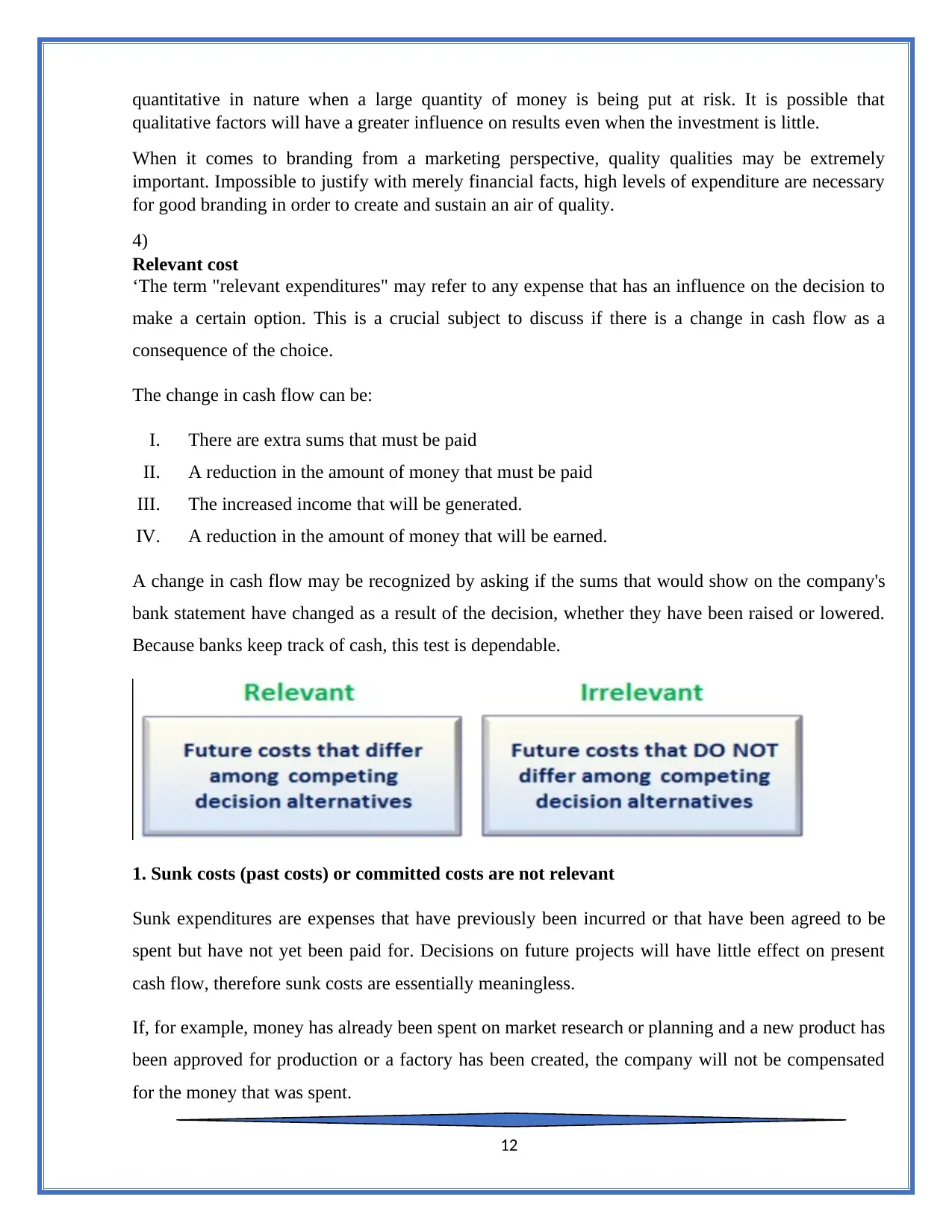
quantitative in nature when a large quantity of money is being put at risk. It is possible that
qualitative factors will have a greater influence on results even when the investment is little.
When it comes to branding from a marketing perspective, quality qualities may be extremely
important. Impossible to justify with merely financial facts, high levels of expenditure are necessary
for good branding in order to create and sustain an air of quality.
4)
Relevant cost
‘The term "relevant expenditures" may refer to any expense that has an influence on the decision to
make a certain option. This is a crucial subject to discuss if there is a change in cash flow as a
consequence of the choice.
The change in cash flow can be:
I. There are extra sums that must be paid
II. A reduction in the amount of money that must be paid
III. The increased income that will be generated.
IV. A reduction in the amount of money that will be earned.
A change in cash flow may be recognized by asking if the sums that would show on the company's
bank statement have changed as a result of the decision, whether they have been raised or lowered.
Because banks keep track of cash, this test is dependable.
1. Sunk costs (past costs) or committed costs are not relevant
Sunk expenditures are expenses that have previously been incurred or that have been agreed to be
spent but have not yet been paid for. Decisions on future projects will have little effect on present
cash flow, therefore sunk costs are essentially meaningless.
If, for example, money has already been spent on market research or planning and a new product has
been approved for production or a factory has been created, the company will not be compensated
for the money that was spent.
12
qualitative factors will have a greater influence on results even when the investment is little.
When it comes to branding from a marketing perspective, quality qualities may be extremely
important. Impossible to justify with merely financial facts, high levels of expenditure are necessary
for good branding in order to create and sustain an air of quality.
4)
Relevant cost
‘The term "relevant expenditures" may refer to any expense that has an influence on the decision to
make a certain option. This is a crucial subject to discuss if there is a change in cash flow as a
consequence of the choice.
The change in cash flow can be:
I. There are extra sums that must be paid
II. A reduction in the amount of money that must be paid
III. The increased income that will be generated.
IV. A reduction in the amount of money that will be earned.
A change in cash flow may be recognized by asking if the sums that would show on the company's
bank statement have changed as a result of the decision, whether they have been raised or lowered.
Because banks keep track of cash, this test is dependable.
1. Sunk costs (past costs) or committed costs are not relevant
Sunk expenditures are expenses that have previously been incurred or that have been agreed to be
spent but have not yet been paid for. Decisions on future projects will have little effect on present
cash flow, therefore sunk costs are essentially meaningless.
If, for example, money has already been spent on market research or planning and a new product has
been approved for production or a factory has been created, the company will not be compensated
for the money that was spent.
12
⊘ This is a preview!⊘
Do you want full access?
Subscribe today to unlock all pages.

Trusted by 1+ million students worldwide
1 out of 16
Related Documents
Your All-in-One AI-Powered Toolkit for Academic Success.
+13062052269
info@desklib.com
Available 24*7 on WhatsApp / Email
![[object Object]](/_next/static/media/star-bottom.7253800d.svg)
Unlock your academic potential
Copyright © 2020–2025 A2Z Services. All Rights Reserved. Developed and managed by ZUCOL.





